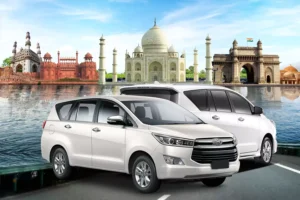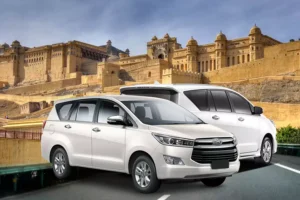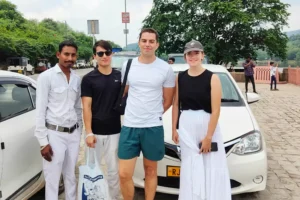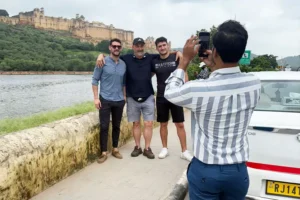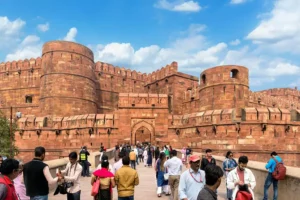Celebrating North India's Colorful Festivals
North India, home to the ancient Indus Valley Civilization, has been shaped by the influences of Aryans, Huns, Greeks, Afghans, and Central Asian dynasties. Each left behind a lasting cultural legacy that continues to define the region’s rich heritage. This historical blend is beautifully reflected in North India’s traditions, art, and its vibrant festivals.
The festivals of North India are grand celebrations that showcase unity in diversity. From ancient rituals to colorful processions, every festival welcomes locals and travelers alike to share in the joy and spiritual energy of the land.
Discover the soul of North India as you explore its most famous festivals — a captivating mix of colors, culture, and devotion that brings history to life. Here’s a glimpse into some of the most cherished celebrations held across this fascinating region.
1. Taj Mahotsav, Agra

Taj Mahotsav is one of the most famous cultural festivals of Agra, Uttar Pradesh, celebrated every year in February near the iconic Taj Mahal. This 10-day event transforms the city into a colorful celebration of Indian art, craft, music, dance, and cuisine. Held during the pleasant spring season, Taj Mahotsav highlights the rich heritage of Uttar Pradesh and other parts of India. Visitors can enjoy traditional performances, art and handicraft exhibitions, folk dances, and delicious local food — all in one vibrant setting. Whether you’re an art lover, a foodie, or a traveler exploring Agra, Taj Mahotsav offers an unforgettable cultural experience that beautifully captures the spirit of Incredible India.
2. Urs festival, Ajmer

The Urs Fair in Ajmer, Rajasthan, is a sacred festival held in memory of Khwaja Moinuddin Chishti, one of India’s most revered Sufi saints. Celebrated every year at the Ajmer Sharif Dargah, this spiritual event attracts thousands of devotees from all faiths and regions.
The Urs takes place during the first six days of the Islamic month of Rajab, marking the saint’s death anniversary, which is observed as a union with the Divine. The atmosphere comes alive with soulful Qawwalis, devotional prayers, and poetic Mushairas, filling the city with peace and devotion.
Visiting the Ajmer Urs Fair offers a deeply spiritual experience, showcasing India’s culture of harmony, faith, and togetherness.
3. Cattle Fair, ( Pushkar Fair ) Pushkar

The Pushkar Camel Fair in Rajasthan is one of the largest and most famous cattle fairs in the world, celebrated with great enthusiasm and cultural charm. Set against the beautiful backdrop of Pushkar’s sand dunes, hills, and lakes, the fair is a vibrant display of Rajasthan’s colorful traditions and rural lifestyle.
Held every year during the Hindu month of Kartik (October–November), starting from Shukla Ekadashi, the event features camel trading, folk performances, competitions, and traditional markets. Travelers can explore handicrafts, enjoy local delicacies, and witness breathtaking desert scenes.
Visiting the Pushkar Camel Fair is a once-in-a-lifetime experience that captures the true spirit of Rajasthan’s culture, spirituality, and desert heritage.
4. Nagaur Fair - UTSAV

The Nagaur Fair in Rajasthan is one of India’s largest and most vibrant cattle fairs, famous for its colorful livestock exhibitions. Held in the historic town of Nagaur, located between Bikaner and Jodhpur, the fair showcases a wide variety of animals, including cows, camels, bullocks, and horses, attracting traders and visitors from across the country.
Taking place annually from late January to mid-February, the event is not just about animal trading — it also reflects Rajasthan’s rich cultural and agricultural traditions. Visitors can experience lively folk performances, local markets, and traditional rituals, making it a fascinating glimpse into rural Indian life.
Attending the Nagaur Fair offers an unforgettable experience of Rajasthan’s heritage, vibrant culture, and bustling market festivities.
5. Desert Festival, Jaisalmer

The Desert Festival in Jaisalmer, Rajasthan is a vibrant celebration that brings the Thar Desert to life with colorful cultural events. This annual festival offers a unique insight into Rajasthan’s rich heritage, showcasing traditional arts, music, and dance.
Visitors can enjoy spectacular performances like Gair and Fire dances, along with entertaining acts by snake charmers, puppeteers, acrobats, and folk artists. The festival also features camel rides, folk dances, camel polo, and the exciting “Mr. Desert” contest, adding to the lively desert experience.
Celebrating the Desert Festival in Jaisalmer is a perfect way to immerse yourself in Rajasthan’s culture, history, and traditions, making it a memorable and unforgettable experience for travelers.
6. Eid al-Fitr

Eid ul-Fitr is one of the most important Muslim festivals, celebrated with great fervor across Northern India and other parts of the world. This festival marks the end of Ramadan, the holy month of fasting, and its date is determined by the sighting of the Crescent Moon according to the Islamic calendar.
In Northern India, Eid ul-Fitr beautifully showcases Muslim culture and traditions. The celebrations are filled with joy, feasting, prayers, and communal gatherings, offering visitors a chance to witness the rich heritage and spiritual spirit of the region. Families come together to share meals, exchange greetings, and spread happiness, making it a vibrant and heartwarming festival.
Experiencing Eid ul-Fitr in Northern India provides a glimpse into the region’s cultural diversity, highlighting both faith and festive cheer in a truly memorable way.
7. Diwali

Diwali, the famous festival of lights, brightens North India with joy, colors, and festive spirit. Celebrated across the country, this vibrant festival sees homes adorned with lamps, diyas, lights, and colorful decorations, while families exchange gifts and sweets. A key part of the celebration is the worship of Goddess Lakshmi, the goddess of wealth and prosperity. The atmosphere is filled with the crackling of firecrackers and the delightful aroma of festive delicacies.
In the holy city of Varanasi, Dev Deepawali is celebrated on Kartik Purnima between November and December. This enchanting festival transforms the ghats of the Ganges River into a spectacular scene as thousands of earthen lamps are floated on the water, creating a mesmerizing display. Tourists and dev
In the sacred city of Varanasi, another enchanting event takes place during Kartik Purnima. Dev Deepawali, celebrated between November and December, transforms the ghats of Varanasi into a mesmerizing spectacle. Thousands of earthen lamps are set afloat on the river, creating a breathtaking visual display that attracts tourists and devotees from across the country.
8. Baisakhi

Baisakhi is a lively and colorful festival celebrated in North India, especially in Punjab, marking the Punjabi New Year. Observed in mid-April, right after the harvest season, this festival is a time of joy, gratitude, and community celebration.
During Baisakhi, people participate in traditional folk dances, music, and vibrant processions, expressing thanks for a successful harvest. Devotees visit temples and offer prayers, while the first harvested crops are presented as offerings to the Gods and Goddesses, symbolizing abundance and prosperity. The festival brings families and communities together, creating an atmosphere of happiness, unity, and cultural pride.
9. Lohri, Punjab

Lohri is a popular festival celebrated in Punjab and other parts of North India, marking the end of winter and the arrival of longer, warmer days. This lively festival holds deep cultural significance and is celebrated with music, dance, and traditional rituals.
Children go from house to house singing folk songs and collecting treats such as munchies and savories. As evening falls, families light a bonfire, throwing the collected offerings into the flames as a symbol of sharing abundance and warmth. People gather around, dancing to traditional tunes, singing, and enjoying the festive spirit together.
Lohri is not only a celebration of the changing season but also a joyous occasion that strengthens community bonds and preserves North Indian cultural traditions.
10. Sindhu Darshan, Kashmir

Sindhu Darshan is an important festival in North India, especially celebrated by the people of Kashmir. It brings visitors from across the region to the source of the River Sindhu in Leh, creating a vibrant gathering of culture and tradition.
Observed in June on Guru Purnima, Sindhu Darshan honors the river and pays tribute to the soldiers who have sacrificed for the nation. The festival highlights the cultural and spiritual significance of the river while promoting respect for nature and the environment.
Celebrating Sindhu Darshan is a reflection of unity, gratitude, and cultural heritage, offering a unique opportunity for people to connect with tradition and honor the bravery of those who serve the country.
11. Phulaich Festival, Kinnaur

The Phulaich Festival is a unique and vibrant tradition celebrated in the Kinnaur district of Himachal Pradesh every September. Lasting for four days, this flower festival is a colorful display of Himachali culture and community spirit.
During the festival, the Rajputs climb a designated mountain to collect flowers, returning the next day to the village. The nights are filled with lively singing, dancing, and cultural performances, creating a joyful and festive atmosphere.
The collected flowers are used in a procession to honor the village deity, and the celebrations also include an animal sacrifice, adding a spiritual aspect to the festival. The Phulaich Festival beautifully showcases the region’s cultural heritage, devotion, and harmonious connection with nature, making it a memorable and meaningful event for locals and visitors alike.
12. Teej, Haryana

Teej is an important and lively festival celebrated in Haryana with great enthusiasm. Falling in the month of Sawan (July-August) according to the Hindu calendar, Teej marks the arrival of the monsoon season and is dedicated to the worship of Lord Shiva and Goddess Parvati.
Women in Haryana celebrate Teej by adorning themselves with red and pink dupattas embroidered with golden thread and applying intricate mehndi designs on their hands. They enjoy swinging on beautifully decorated swings and singing traditional songs throughout the day, creating a vibrant and joyous atmosphere.
The festival of Teej not only highlights the cultural heritage of Haryana but also reflects the deep connection between nature, spirituality, and community celebration, making it a cherished and colorful occasion for everyone.
13. Lathmar Holi, Barsana

Lathmar Holi is a unique and vibrant festival celebrated in Barsana, Uttar Pradesh. This festival is inspired by the playful tales of Lord Krishna, who visited Nandgaon to celebrate Holi with Radha and her companions.
According to tradition, the Gopis playfully chased Krishna and his friends with bamboo sticks or "lathis". This charming custom continues today, as women in Barsana joyfully chase and lightly "beat" visiting men from Nandgaon, recreating the playful spirit of the legend.
Lathmar Holi not only celebrates the mythological love of Radha and Krishna but also showcases the lively and joyous cultural traditions of Uttar Pradesh, making it a must-see festival full of color, fun, and camaraderie.
14. Kumbh Mela, Allahabad

Kumbh Mela is a grand spiritual festival held in Allahabad, Uttar Pradesh, lasting nearly a month. Recognized as one of the largest religious gatherings in the world, it attracts millions of pilgrims from across India and abroad.
The festival takes place at the sacred confluence of the Ganga, Yamuna, and Saraswati rivers between January and February. According to Hindu beliefs, taking a dip in these holy waters during Kumbh Mela washes away sins and brings spiritual purification, blessings, and renewal.
Visiting Kumbh Mela offers a once-in-a-lifetime experience to witness India’s deep-rooted spiritual traditions, rituals, and cultural heritage, making it a transformative and unforgettable event for devotees and travelers alike.
15. Ram Navami, Ayodhya

Ramnavami is an important Hindu festival that celebrates the birth of Lord Rama and holds special significance in Ayodhya, Uttar Pradesh. Devotees participate in religious rituals, processions, and prayers, honoring the life and virtues of Lord Rama.
Similarly, Janmashtami, observed in Mathura, the birthplace of Lord Krishna, is celebrated with grand festivities, devotional singing, and vibrant displays of culture. The celebrations include traditional dances, midnight prayers, and enactments of Krishna's childhood stories.
Both festivals offer a glimpse into India’s rich mythological heritage and showcase the deep devotion and reverence people hold for these revered deities, making them an integral part of North India’s cultural and spiritual landscape.
16. Mata Murti Ka Mela, Uttarakhand

Mata Murti Ka Mela is a distinctive annual festival celebrated in Champavat, Uttarakhand every September. This festival honors the Mother of Badrinath and holds deep religious significance for devotees.
The event features a lively fair near the revered Badrinath Temple, where people gather to offer prayers, participate in rituals, and enjoy cultural activities. The festivities create a vibrant atmosphere filled with devotion, community spirit, and celebration.
Celebrating Mata Murti Ka Mela provides an opportunity for devotees to connect with their spiritual heritage, witness traditional customs, and experience the rich cultural and religious legacy of Uttarakhand.
17. Magh Mela, Uttarakhand

Magh Mela is an important cultural and religious festival celebrated in the Kumaon region of Uttarakhand during Sankranti. This vibrant event holds great significance in North India’s cultural and spiritual heritage, attracting devotees and travelers alike.
The festival offers a unique glimpse into the traditions, rituals, and festivities of the region, making it a must-visit for those seeking a rich cultural experience. Pilgrims gather to participate in holy rituals, community gatherings, and seasonal celebrations that reflect the spiritual essence of Uttarakhand.
For travelers looking to experience North India’s vibrant festivals, consider our thoughtfully curated tour packages, including the Chardham Package, Golden Triangle with Golden Temple Tour, and Golden Triangle with Varanasi Tour (Ganges Tour). These packages provide an immersive journey through the region’s colorful events, sacred sites, and cultural landmarks.
18. Jaipur Literature Festival

The Jaipur Literature Festival is a renowned annual event held in Jaipur, Rajasthan, celebrated as one of the world’s largest literary festivals. It serves as a vibrant platform for authors, poets, thinkers, and literary enthusiasts from around the globe to come together and share ideas.
The festival highlights literature in all its forms, including fiction, non-fiction, poetry, history, and more. Attendees participate in engaging discussions, debates, readings, and cultural exchanges, creating an energetic environment that encourages intellectual exploration and creativity.
Recognized internationally for promoting literature, arts, and ideas, the Jaipur Literature Festival has become a must-attend event for writers, readers, and anyone passionate about creative expression and cultural dialogue.
19. Gangaur

Gangaur is a traditional and colorful festival celebrated in the Indian state of Rajasthan, particularly in the city of Jaipur. It is dedicated to the goddess Gauri, who represents purity, marital bliss, and prosperity. The festival takes place in the month of Chaitra (March-April), marking the end of winter and the arrival of spring.
During Gangaur, married women pray for the well-being and long life of their husbands, while unmarried women seek blessings for a worthy spouse. The festivities typically last for around 18 days and include various rituals, processions, and cultural performances.
Women dress in vibrant Rajasthani attire, donning traditional jewelry and applying intricate mehndi (henna) designs on their hands. They carry beautifully decorated pots on their heads, symbolizing the harvest and fertility, while singing folk songs and dancing as they parade through the streets.
The most visually captivating aspect of Gangaur is the stunningly adorned idols of Gauri, which are elaborately decorated and taken on processions. The idols are immersed in water bodies on the final day of the festival, symbolizing the departure of the goddess and the conclusion of the celebrations.
Gangaur not only reflects the rich cultural heritage of Rajasthan but also showcases the strong bond between married couples and the importance of family and relationships in the region's social fabric.
20. Rann Utsav

The Rann Utsav is an annual cultural festival that transforms the white sands of Gujarat’s Rann of Kutch into a vibrant celebration from November to February. Visitors are welcomed into traditional Gujarati-style tents that host a variety of activities, including folk dances, skits, and cultural programs every evening.
As the sun sets, the desert comes alive with bonfires, musical performances, and delectable dining experiences, creating a magical atmosphere. This festival beautifully showcases Gujarat’s rich heritage and cultural traditions, making it a must-visit for travelers seeking an immersive cultural experience.
The Rann Utsav offers a unique opportunity to experience the art, music, and lifestyle of Gujarat against the breathtaking backdrop of the

